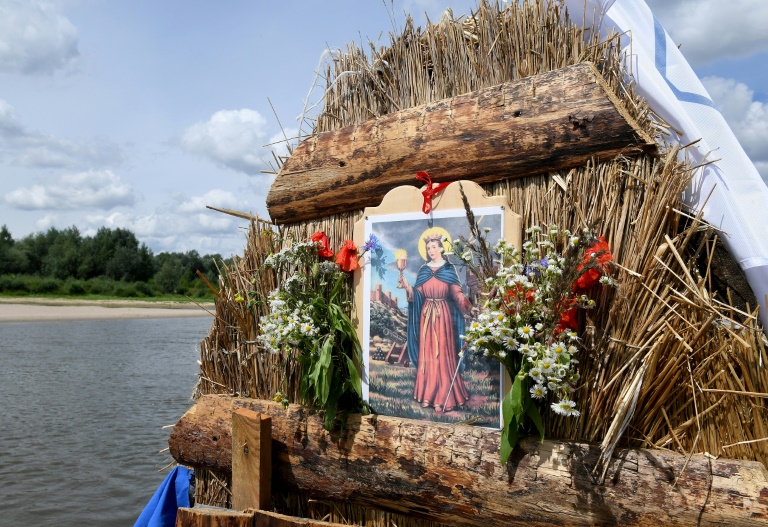Their day begins at dawn with a prayer — “When dawn breaks, the earth, the sea, all of nature praises you” — which captain Zdzislaw Nikolas sings in his bass voice while the whole crew stands around an image of their patron saint.
They sing it at night too like their ancestors, says Nikolas, who sports an impressive handlebar moustache.
“Saint Barbara was the patron of those with dangerous jobs, like miners and firefighters and also raftsmen, because that too was a dangerous job: there was a strong river current in the spring,” he adds.
For centuries, timber floating brought wealth to many villages along the Vistula and its tributaries. Men sent merchandise of all kinds but especially wood from the forests of southern Poland downstream to the Baltic port of Gdansk.
“As soon as the ice melted on the Vistula and the currents of the Vistula and the (tributary) San were flowing freely, raft makers got to work and sent the wood floating down to Gdansk,” Nikolas says while steering from the back.
“The whole village of Ulanow did this job and it was often a family affair passed down from father to son. It disappeared with the beginning of the war in 1939 when the German army’s bombs destroyed the bed of the Vistula river.”
After the war, timber floating was replaced by trucks and trains.
– Wild river –
In 1991, Nikolas revived a brotherhood of Ulanow raftsmen who organised their first descent last year.
“Ours is the most extensive timber floating today in Europe… We do it out of passion, to revive this trade. Not for financial reasons,” he said.
The crew left Ulanow, a village in the southeast of Poland, on July 2 and floated down the San. They hope to do the 724 kilometres (450 miles) between their village and the Baltic in 29 days.
Two weeks in, they were docked on a beach in Gassy, a couple of kilometres from Warsaw.

They pray before Saint Barbara every morning and every night
Their raft is made up of four smaller ones assembled by tying together long planks of pinewood. It weighs 50 tonnes and is 70 metres (230 feet) long. The first and last rafts are used to steer.
This year the descent is happening as Poland celebrates “The Year of the Vistula”.
It is a very wild river that has known little development and dredging. Shallow in some areas, there are tree trunks hidden underwater that can jam a raft.
– Polish wood in Amsterdam –
Back in the day the raftsmen put a whole lot at the mercy of the river, Nikolas said.
“Wood merchants would entrust their merchandise with the raftsman, who often risked losing everything he owned, his house, his wife and children — all of which he would bond,” he said.
“Once the wood arrived in Gdansk, it was cut in saw mills and then exported throughout the world,” he added.
“It is even said that the whole city of Amsterdam was constructed with Polish wood, all of those beautiful houses, entire neighbourhoods of the port made with pine that grew in Poland. These pines were exported to make masts for sailboats in England and Norway.”
The raftsmen sleep in traditional thatched tents and cook meals on an ever-burning fire.
“Two weeks into the descent, almost all our supplies are gone,” says Zygmunt Osip, as he added cabbage to a big cooking pot.
He did last year’s descent and joined the crew again this year.
“I did everything to get time off work and for my wife to let me leave and I succeeded, I’m here,” he told AFP.
“For me this trip is as beautiful as first love.”
Download our app